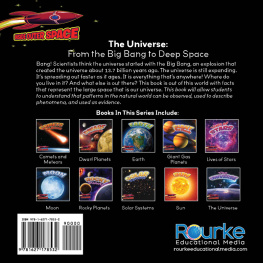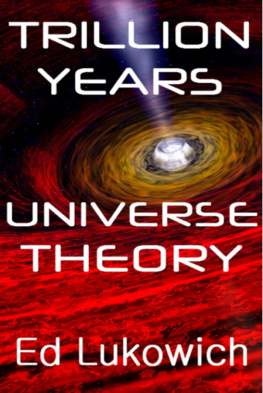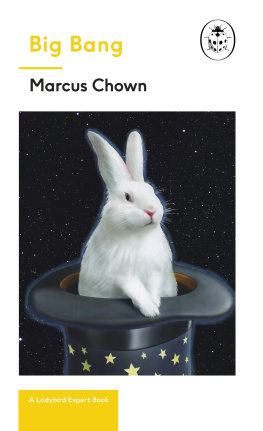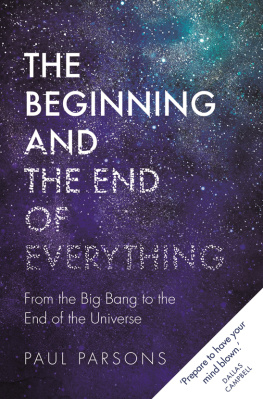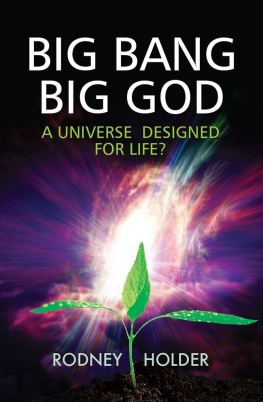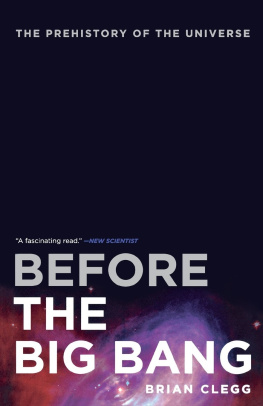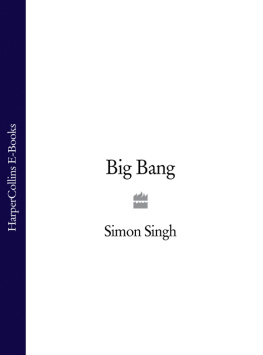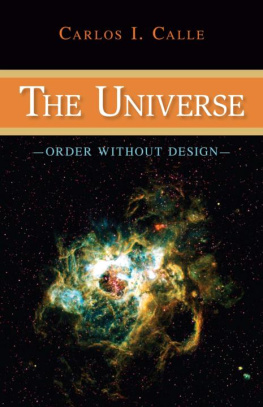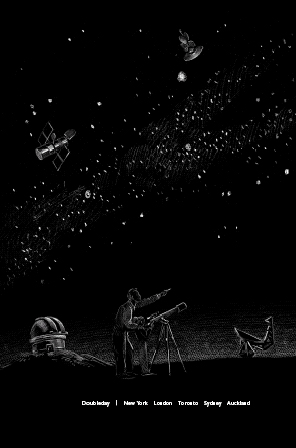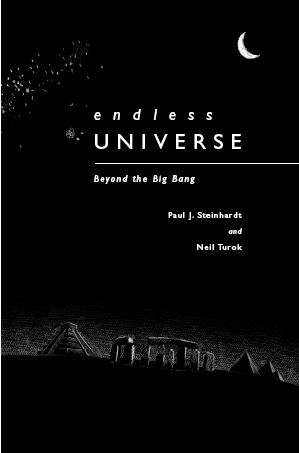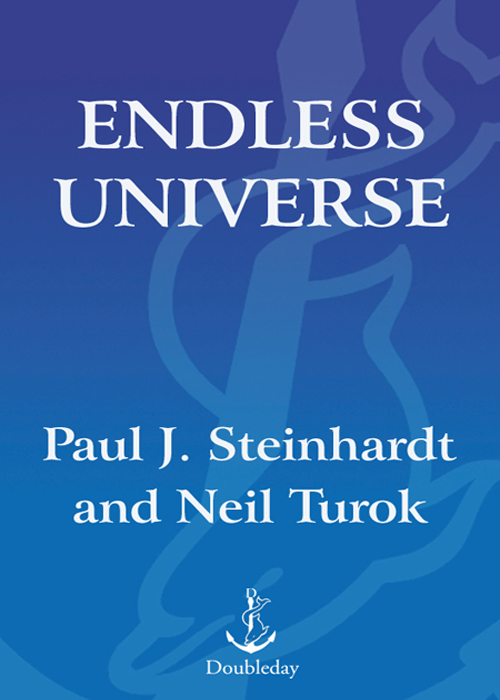
contents

To Nancy and Corinne
acknowledgments

Endless Universe was, in part, a family affair. The book could never have been completed without the love, patience, and support of Nancy and Corinne. Working on each side of the Atlantic, they were our most dedicated readers, our most exacting editors, our harshest critics, and our best morale boosters. Pauls sisters, Alice and Nancy Steinhardt, and brother-in-law Bob Sorensen, and Neils parents, Ben and Mary, read early versions and gave vital guidance. Pauls sister-in-law Chana Shapiro meticulously reviewed the manuscript and helped us to resolve numerous structural issues, especially how to design a story told with two voices. Our children, Charlie, Joe, Will, and Cindy Steinhardt, and Ruby Turok-Squire, all helped to shape the text and the illustrations.
We also are extremely grateful to the numerous colleagues who took time to read all or parts of the manuscript and to give us their valuable advice, including Andreas Albrecht, Brian Greene, Stephen Hawking, Burt Ovrut, Roger Penrose, Martin Rees, Michael Turner, and Edward Witten. Daniel Baumann, Jean-Luc Lehners, and Paul McFadden carefully reviewed the physics presentation throughout the manuscript. Michael Olenick contributed many useful comments. Peter Galison, Gerald Holton, Peter Schaefer, and Jeffrey Tigay provided guidance on the historical issues discussed in Chapter 8. We thank Carl Feinberg for suggesting that we consider the relationship between the cyclic model and Asimovs short story The Last Question.
Many have contributed to our scientific and personal lives, as well as to the ideas described herein. The imprint of our mentors, Richard Feynman, Sidney Coleman, David Olive, and Tom Kibble, can be found throughout this book. For Paul, Alan Guth was profoundly important in drawing him into the field of cosmology (see Chapter 5). He, Michael Turner, and Andreas Albrecht were influencial early in Pauls career and have been longstanding friends ever since. Many at Cambridge and Princeton have provided invaluable guidance, including John and Neta Bahcall, Gary Gibbons, David Gross, Stephen Hawking, Jerry Ostriker, Lyman Page, Jim Peebles, Malcolm Perry, Martin Rees, Nathan Seiberg, David Spergel, Scott Tremaine, David Wilkinson, and Edward Witten.
In developing the cyclic model, we have been fortunate to have a cadre of outstanding collaborators. Burt Ovrut, a longtime collaborator and friend of Pauls, started us down the path toward the cyclic model with his fateful talk in Cambridge in August 1999 (see Chapters 1 and 6) and has been extraordinarily important in exploring its relation to string theory. A remarkable graduate student, Justin Khoury, was the first to join the team and played a pivotal role in developing the physical principles underlying the first colliding brane models. Nathan Seiberg collaborated on one of the early papers and has been a constant source of advice. A series of talented and creative students and postdoctoral fellows followedLatham Boyle, Joel Erickson, Steven Gratton, Jean-Luc Lehners, Paul McFadden, Gustavo Niz, Andrew Tolley, and Daniel Wesleyall have made major contributions to unveiling new physical principles and transforming the conceptual framework into a concrete, mathematical model. Many other theorists have contributed to the cyclic model through ideas, criticisms, and insights, including Lawrence Abbott, James Bardeeen, Thorsten Battefeld, Martin Bojowald, Robert Brandenberger, Sean Carroll, Ben Craps, Paolo Creminelli, Anne Davis, Ruth Durrer, Pyotr Horava, Gary Horowitz, Renata Kallosh, Lev Kofman, James Lidsey, Andrei Linde, Roy Maartens, V. (Slava) Mukhanov, Subhod Patil, Fernando Quevedo, Lisa Randall, Alexander Vilenkin, David Wands, and Matias Zaldarriaga. We also thank the United States Department of Energy and the Particle Physics and Astronomy Research Council in the United Kingdom for supporting our research described in this book.
Pier Gustafson, our outstanding illustrator, worked tirelessly to turn our crude ideas into illustrations that help to give the book the relaxed feel we were seeking. We were also lucky to recruit Stewart Dickson to work with us in developing the idea of a double-Klein bottle into a cover image that represents symbolically an endless cyclic universe. We also thank Laura van Dam and Chad Boutin for their professional editorial advice on early versions of the manuscript.
We are most grateful to Charlie Conrad, our editor at Broadway Books, and his assistant, Jenna Thompson, for their patience, advice, and support throughout the project. We appreciate the care that copyeditor Bonnie Thompson gave to the manuscript, and we thank Angela Glenn for painstakingly incorporating the edits into the final draft. Finally, we thank Katinka Matson and John Brockman for their help throughout, beginning with a sketchy concept, helping us formulate it into a book proposal, finding Charlie Conrad and Broadway Books to work with us, and providing many opportunities to bring the book and its ideas to the attention of the public.
preface

There is a theory which states that if ever anyone discovers exactly what the Universe is for and why it is here, it will instantly disappear and be replaced by something even more bizarre and inexplicable. There is another theory which states that this has already happened.
Douglas Adams, The Restaurant at the End of the Universe
Theories of the universe have abounded throughout human history, but the last forty years have been exceptional. A single theory, the hot big bang picture, has dominated scientific and public discourse and has even become part of the standard curriculum for schoolchildren. Its central tenet, the idea that the universe emerged from a very hot, dense state 14 billion years ago and has been expanding and cooling ever since, has been firmly established through many independent measurements. But nearly every other feature of the theory has had to be modified. One ingredient after anotherdark matter, inflation, dark energyhas been added and separately adjusted to fit the observations, and each of these adjustments has critically altered our conception of the history of the universe. Even so, the picture remains far from complete. The big bang is conjectured to be the beginning of time and space, but there is no clue as to how or why the big bang occurred. Nor is there a firm prediction about the future of the universe. Most cosmologists do not consider these flaws to be worrisome. They think that the theory will ultimately be simplified and made more complete. And perhaps they are right, Douglas Adamss joke notwithstanding.
This book concerns the emergence of a new theory of the universe, according to which our cosmic history consists of repeating cycles of evolution. Each cycle begins with a bang, but the bang is not the beginning of space or time. Rather, it is an event with a before and an after that can be described by the laws of physics. Each cycle influences the next. The events that occurred before the last bang shaped the large-scale structure of the universe observed today, and the events that are occurring today will determine the structure of the universe in the cycle to come. Perhaps space and time sprang into being many cycles ago, but it is also possible that they are literally endless.
Next page

